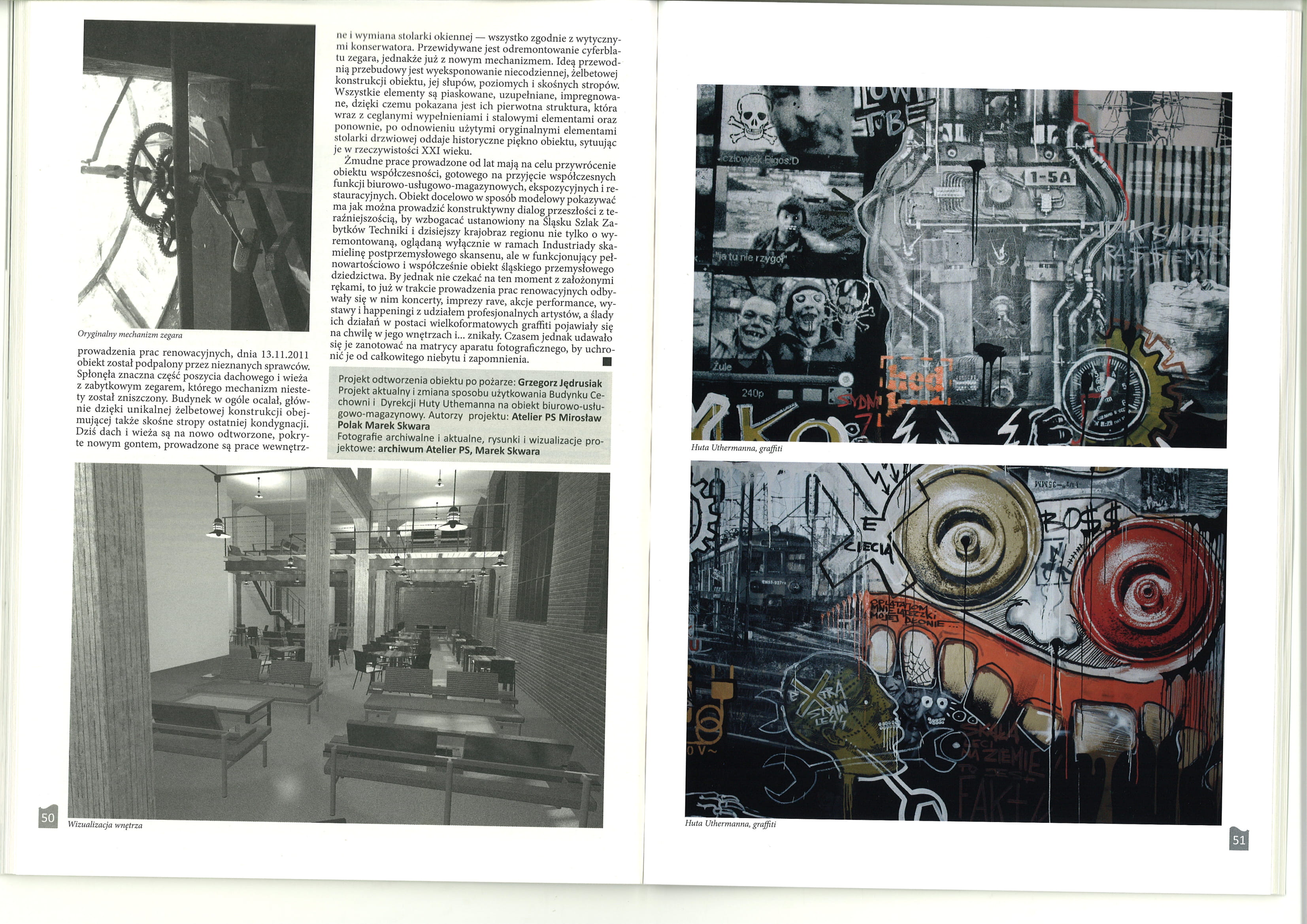In ŚLĄSK 03./2019 issue a text “Uthemann Yesterday and Tomorrow” treating on Uthemann Zink Plant Office Building located in Katowice-Szopienice was published. The remnants of the Plant are being transformed into office-service-storage building according to ATELIER PS project. Marek Skwara writes about historical inspirations of the architects Emil and Georg Zillman, former and future life of the object and current artistic events which take place in the building. Some, large format graffiti photographs accompany architectural pictures.
The design of the Hall and the Management of Uthemann Zink Plant obtained a building permit in 1911. Today, together with the water tower, it is one of the last remaining buildings of a huge industrial complex of a zinc smelter operating on an area of 150,000 m2, built by the Georg von Giesche's Erben mining and metallurgical concern at the turn of the 19th and 20th centuries in Szopienice, today's district of Katowice. The hall was originally the seat of the company's management board, it served as a meeting place for employees, it housed the production and design offices of the steelworks, and laboratories. It was included in the multi-level spatial layout of the steelworks, connected by railroad flyovers, organized along the north-south and east-west axes.
The design was developed by architects Emil and Georg Zillman, born in Międzyrzecz, in today's Lubuskie Province, in the early 1870s. Educated at the Royal University of Technology in Charlottenburg near Berlin, they founded a joint design office in 1902. After designing the reconstruction of the manor house in Załęże in Katowice in 1905 and in 1906 the Metallurgical Hospital in Roździeń, they became its court architects. Authors of, among others, famous housing estates in Giszowiec and Nikiszowiec in Katowice and the Szombierki heat and power plant in Bytom, reminiscent of brick, medieval fortified castles in Pomerania.
The construction of the hall of the hall was completed in 1912, i.e. the monumental Centennial Hall by Max Berg in Wrocław, similar to the reinforced concrete structure, was built. Architects, however, could have drawn direct inspiration from a different building. It was the Market Hall in Wrocław, which was built according to the design of Richard Plüddemann and Heinrich Küster in 1906-08. Its structure is made of reinforced concrete parabolic arches with dimensions comparable to the Szopienice building: support spacing 20.65 m and a height of just over 17 m. All these objects - of which the Huta Uthemann hall is somewhat forgotten, are among the first structures of this type in today's Poland. What's more, they are pioneering engineering achievements of reinforced concrete construction in the world.
Właścicielem obiektu od kliku lat jest firma Silesia Jeans. Żmudne prace prowadzone od lat mają na celu przywrócenie obiektu współczesności, gotowego na przyjęcie współczesnych funkcji biurowo-usługowo-magazynowych, ekspozycyjnych i restauracyjnych. Obiekt docelowo w sposób modelowy pokazywać ma jak można prowadzić konstruktywny dialog przeszłości z teraźniejszością, by wzbogacać ustanowiony na Śląsku Szlak Zabytków Techniki i dzisiejszy krajobraz regionu nie tylko o wyremontowaną, oglądaną wyłącznie w ramach Industriady skamielinę postprzemysłowego skansenu, ale w funkcjonujący pełnowartościowo i współcześnie obiekt śląskiego przemysłowego dziedzictwa. By jednak nie czekać na ten moment z założonymi rękami, to już w trakcie prowadzenia prac renowacyjnych odbywały się w nim koncerty, imprezy rave, akcje performance, wystawy i happeningi z udziałem profesjonalnych artystów, a ślady ich działań w postaci wielkoformatowych graffiti pojawiały się na chwilę w jego wnętrzach i …. znikały. Czasem jednak udawało się je zanotować na matrycy aparatu fotograficznego, by uchronić je od całkowitego niebytu i zapomnienia.


